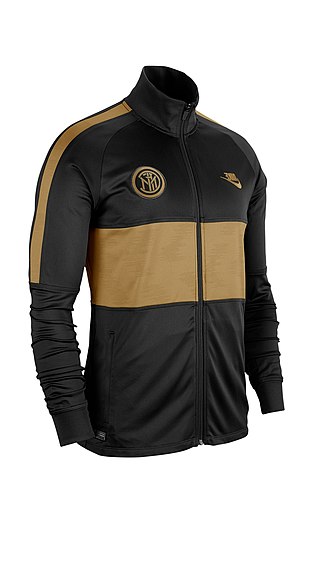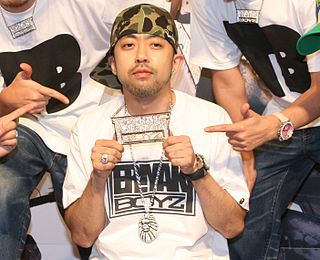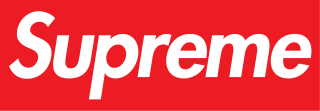
Hip-hop fashion refers to various styles of dress that originated from Urban Black America and inner city youth in cities like New York City, Atlanta, and Los Angeles. Being a major part of hip hop culture, it further developed in other cities across the United States, with each contributing different elements to the overall style that is now recognized worldwide.

A tracksuit is an article of clothing consisting of two parts: trousers and a jacket usually with front zipper. It was originally intended for use in sports, mainly for athletes to wear over competition clothing and to take off before competition. In modern times, it has become commonly worn in other contexts. The tracksuit was one of the earliest uses of synthetic fibers in sportswear.
Yakira, L.L.C. is an American urban fashion company founded by Marc Ecko in 1993. The company makes apparel and accessories under the brands Ecko Unltd. line for men and the Ecko Red line for girls and women. It is headquartered in New York City. The company's products gained public attention in the late 1990s; they were originally associated with hip-hop and skate culture and moved into mainstream urban culture in the early 2000s. It is most often associated with hip-hop. The style is based on graffiti art. Its brand features a rhino as its logo. Rap artist MC Serch of 3rd Bass assisted with marketing in the early years of the company.
Japanese street fashion refers to a number of styles of contemporary modern clothing in Japan. Created from a mix of both local and foreign fashion brands, Japanese street fashions tend to have their own distinctive style, with some considered to be extreme and avant-garde, with similarities to the haute couture styles seen on European catwalks.

Fashion of the 1980s was characterized by a rejection of 1970s fashion. Punk fashion began as a reaction against both the hippie movement of the past decades and the materialist values of the current decade. The first half of the decade was relatively tame in comparison to the second half, which was when apparel became very bright and vivid in appearance.

The fashion of the 2000's is often described as a global mash up, where trends saw the fusion of vintage styles, global and ethnic clothing, as well as the fashions of numerous music-based subcultures. Hip-hop fashion generally was the most popular among young people of all sexes, followed by the retro inspired indie look later in the decade.

History of fashion design refers specifically to the development of the purpose and intention behind garments, shoes, accessories, and their design and construction. The modern industry, based around firms or fashion houses run by individual designers, started in the 19th century with Charles Frederick Worth who, beginning in 1858, was the first designer to have his label sewn into the garments he created.

Sneaker collecting is the acquisition and trading of sneakers as a hobby. It is often manifested by the use and collection of shoes made for particular sports, particularly basketball and skateboarding. A person involved in sneaker collecting is sometimes called a sneakerhead.
Kiks Tyo is a Japanese fashion brand founded by DJ, designer, photographer and streetwear/sneaker culture personality hobby:tech in 2006.

Street style is fashion that is considered to have emerged not from studios, but from the grassroots. Street fashion is generally associated with youth culture, and is most often seen in major urban centers. Magazines and newspapers commonly feature candid photographs of individuals wearing urban, stylish clothing. Mainstream fashion often appropriates street fashion trends as influences. Most major youth subcultures have had an associated street fashion. Street style is different all around the globe.

Adidas Originals is a brand of a line of casual and sportswear created by German multinational corporation Adidas. It consists of a heritage line, specializing in athletic shoes, t-shirts, jackets, bags, sunglasses and other accessories.

Nigö is a Japanese fashion designer, disc jockey (DJ), record producer and entrepreneur. He is best known as the creator of the streetwear brand, A Bathing Ape (Bape), and currently serves as artistic director for Kenzo. Additionally he is a member of the Japanese group Teriyaki Boyz, serving as their official in-house DJ since the group's 2005 debut.

Stüssy is an American privately held fashion house founded in the early 1980s by Shawn Stussy. It benefited from the surfwear trend originating in Orange County, California, but was later adopted by the skateboard and hip hop scenes.

The 2010s were defined by hipster fashion, athleisure, a revival of austerity-era period pieces and alternative fashions, swag-inspired outfits, 1980s-style neon streetwear, and unisex 1990s-style elements influenced by grunge and skater fashions. The later years of the decade witnessed the growing importance in the western world of social media influencers paid to promote fast fashion brands on Pinterest and Instagram.

Supreme (səˈpriːm) is an American clothing and skateboarding lifestyle brand established in New York City in April 1994. Supreme is recognized for its influence on streetwear culture, with products that cater to skateboarding and urban fashion trends. The company makes skateboards in addition to clothing and accessories. The red box logo with "Supreme" in white Futura Heavy Oblique is thought to be largely based on Barbara Kruger's art. VF Corporation, a US-based apparel and footwear company, bought Supreme for $2.1 billion in December 2020.

Athleisure is a hybrid style of athletic clothing typically worn as everyday wear. The word is both a neo-logism and portmanteau combining the words 'athletic' and 'leisure'. Athleisure outfits can include tracksuits, sports jackets, hoodies, yoga pants, tights, sneakers, leggings and shorts that look like athletic wear, characterized as "fashionable, dressed-up sweats and exercise clothing". Since the 2010s, the pervasiveness of the athleisure phenomenon has experienced a significant surge in popularity, particularly within the everyday life and daily routines of mainstream North Americans. This trend entails individuals opting to incorporate athletic clothing into their everyday attire, irrespective of their actual engagement in physical activities or not.
Hype in marketing is a strategy of using extreme publicity. Hype as a modern marketing strategy is closely associated with social media.
Yoon Ahn is an American businesswoman and fashion designer. She studied graphic design at Boston University and graduated in 2000. She is known as the creative director of her brand Ambush and as Dior Men's jewelry design director. Ahn is currently based in Tokyo, Japan.

The fashions of the 2020s represent a departure from 2010s fashion and feature a nostalgia for older aesthetics. They have been largely inspired by styles of the early-to-mid-2000s, late 1990s, 1980s, 1970s, and 1960s. Early in the decade, several publications noted the shortened trend and nostalgia cycle in 2020s fashion. Fashion was also shaped by the COVID-19 pandemic, which had a major impact on the fashion industry, and led to shifting retail and consumer trends.

Warren Lotas is a Los Angeles–based streetwear company. Started in 2014 and incorporated in 2018, Warren Lotas is best known for its graphic-heavy T-shirts and hoodies. While most items are sold via E-commerce, Warren Lotas also has a retail store location in Los Angeles, and its clothing can be found in luxury department stores around the world.


















